Clipart tagged: ‘minor axis’

Corresponding Points in an Ellipse and Circle
Illustration of half of an ellipse. "The ordinates of two corresponding points in an ellipse and its…
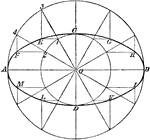
Construction of Ellipse by Describing Circles
Illustration used to draw a an ellipse using string and pins by describing a circles with diameters…

Conjugate Diameters of an Ellipse
Illustration showing that if one diameter is conjugate to a second, the second is conjugate to the first.

Construction of an Ellipse
Illustration of half of an ellipse and its auxiliary circle used to construct an ellipse by points,…

Construction of Ellipse
Illustration used to draw a an ellipse with major axis AB and minor axis CD.

Construction of an Ellipse
Diagram showing how to construct an ellipse when given the two foci and the length of the major axis…
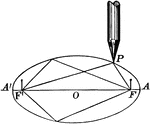
Demonstration of Ellipse Definition
Illustration showing the definition of an ellipse. "An ellipse is a curve which is the locus of a point…

Focal Radii of an Ellipse
Illustration of half of an ellipse. "If d denotes the abscissa of a point of an ellipse, r and r' its…
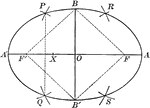
Ellipse With Parts Labeled
Illustration of an ellipse with foci F' and F, major axis A' to A, minor axis B' to B, and center O.

Line Bisecting Angle Between Focal Radii on Ellipse
Illustration of half of an ellipse. "If through a point P of an ellipse a line is drawn bisecting the…

Ordinate and Major Axis of Ellipse
Illustration of half of an ellipse. The square of the ordinate of a point in an ellipse is to the product…
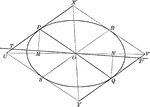
Parallel Tangents to an Ellipse
Illustration showing that tangents drawn at the ends of any diameter are parallel to each other.

Point Distances to Foci on Ellipse
Illustration of half of an ellipse. "The sum of the distances of any point from the foci of an ellipse…

Tangent From External Point to an Ellipse
Illustration of how to draw a tangent to an ellipse from an external point.

Tangents to an Ellipse
Illustration showing the tangents drawn at two corresponding points of an ellipse and its auxiliary…
2 Ellipses With Equal Vertical Axes
An illustration of 2 ellipses that have the equal vertical axes, but different horizontal axes. The…

2 Ellipses With Equal Vertical Axes
An illustration of 2 ellipses that have the equal vertical axes, but different horizontal axes. The…

3 Concentric Ellipses
An illustration of 3 concentric ellipses that are tangent at the end points of the vertical axes. The…

3 Concentric Ellipses
An illustration of 3 concentric ellipses that are tangent at the end points of the vertical axes, which…

3 Concentric Ellipses
An illustration of 3 concentric ellipses that are tangent at the end points of the vertical axes. The…
4 Concentric Ellipses
An illustration of 4 concentric ellipses that are tangent at the end points of the vertical axes. The…

4 Concentric Ellipses
An illustration of 4 concentric ellipses that are tangent at the end points of the vertical axes. The…

4 Concentric Ellipses
An illustration of 4 concentric ellipses that are tangent at the end points of the vertical axes, which…

5 Concentric Ellipses
An illustration of 5 concentric ellipses that are tangent at the end points of the vertical axes. The…

5 Concentric Ellipses
An illustration of 5 concentric ellipses that are tangent at the end points of the vertical axes, which…

6 Concentric Ellipses
An illustration of 6 concentric ellipses that are tangent at the end points of the vertical axes. The…

6 Concentric Ellipses
An illustration of 6 concentric ellipses that are tangent at the end points of the vertical axes, which…
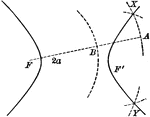
Construction of a Hyperbola
Diagram showing how to construct a hyperbola when given the two foci and the length of the major axis…
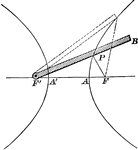
Demonstration of Hyperbola Definition
Illustration showing the definition of an hyperbola. "An hyperbola may be described by the continuous…
